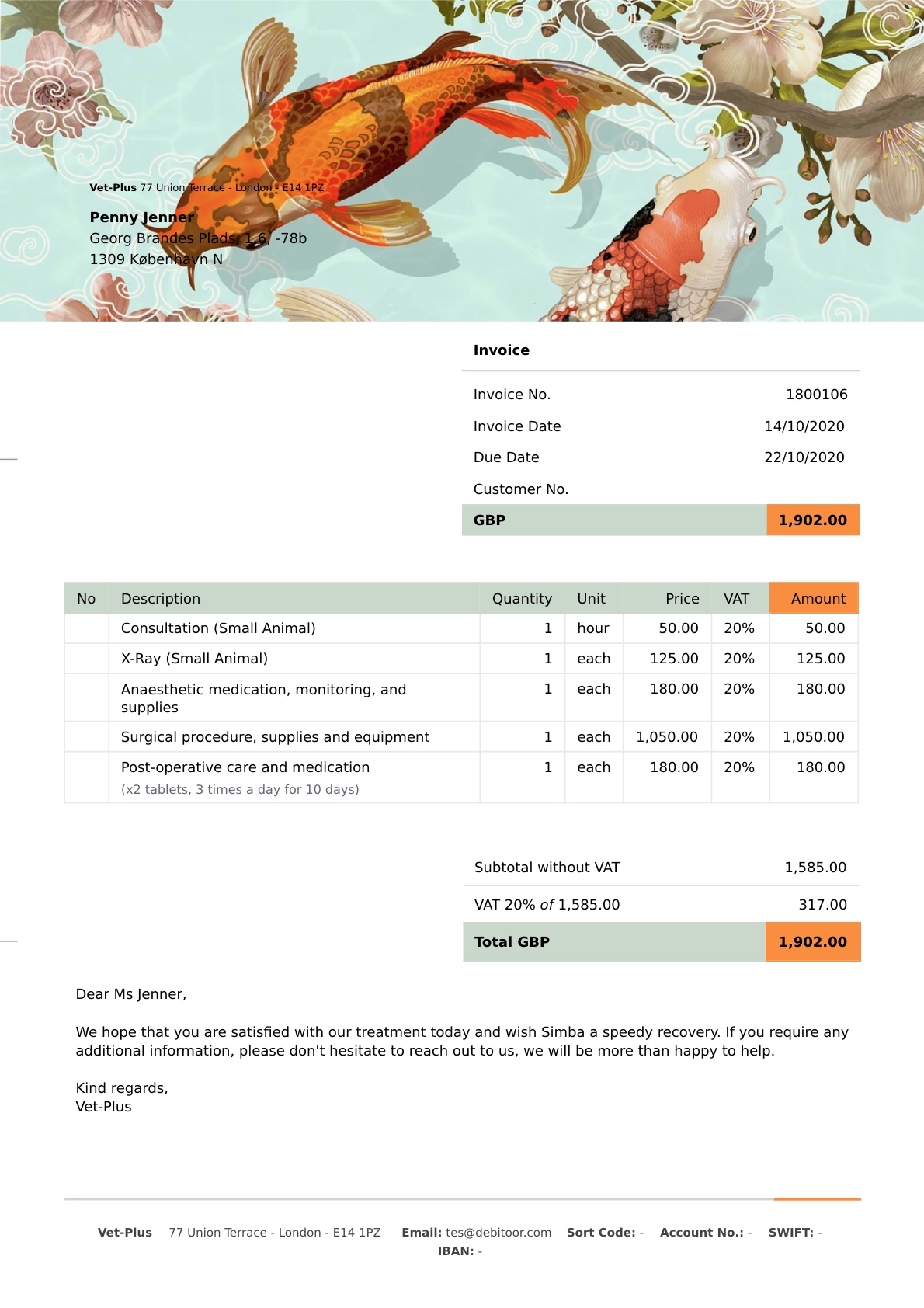Every animal has its own unique specific needs, and no two pets are alike. If you work as a vet, this also means no two invoices for your veterinary services will be alike either. But that doesn’t mean vet invoices need to be difficult.

Invoicing software can create veterinary invoices in no time, as well as organising the practice’s records and accounts and helping to minimise missed payments.
This article explores how veterinary practices can get the most out of their invoicing software and explains how best to format a vet invoice.
How is invoicing software helpful for veterinary practices?
Your veterinary invoice is a legal document that is used to collect payment for services that your practice has provided. However, if you invoice your clients using invoicing software, it can be used for much more than just settling the bill.
By using invoicing software, you can keep a financial record of your accounts and prepare yourself for the end of year accounting. It’s also possible to record your expenses, generate profit and loss reports, and monitor the growth of your business.
If you use invoicing software to create your veterinary invoices, you will be able to:
- Clarify the different services and procedures you have performed
- Simplify payment options
- Keep track of due dates and minimise late payments
- Keep records of client account information
- Perform accounting procedures with ease.
Simplify your invoicing with a veterinary invoice template
But, to be able to do these things, you need to firstly create your invoices. The quickest way to create a vet’s invoice is to have a pre-made invoice template. Your invoicing software will provide you with this.
Rather than having to write a new one every time, you can simply fill out the template with the necessary information and your invoicing software will automatically create the vet invoice for you.
What will your invoice template for your veterinary services include?
Your invoice template will include:
- A unique invoice number. This should be automatically generated for you in line with your numbering sequence.
- Space for your client’s name and contact details
- Boxes for the different dates you need to write; i.e., the invoice date and the date the veterinary services were provided.
- Space to include the terms of payment.
- Space to list the different things you are charging for and the costs.
Normally, any invoice template will also provide you with space to make any additional notes. People love their pets, and so it may be a nice idea to also add a personalised message about Spot or Jackson and thank your client again for entrusting the care of their pet to you.
Your invoice template will then automatically generate your invoice with the total amount that is due, include the title of the document, i.e. ‘Invoice’, and add your name and contact details.
Itemize your veterinary invoice using invoicing software
When you create your invoice, make sure to itemize your services appropriately. It’s very important that your invoice is detailed enough that your client can see the full value of the services that were provided.
Whilst owners will commonly know everything that goes on with their pets outside of the vets, they’re less likely to know exactly what happens at the practice. They will not necessarily understand the amount of work, medication and skill that goes into helping their animals.
Therefore, rather than simply listing ‘surgery’ for price of £2,000, you should list the different things that this included. Mention that the surgery included X-rays, administering anaesthetics, the use of different supplies, and any additional aftercare. By doing this, the customer will be better equipped to fully appreciate how their money was spent and why the surgery was the price it was.

By providing a list of the different services on an easy-to-understand invoice will help them to get an overview of the treatment and reinforce your reputation as a reputable and trusted veterinarian. Clients won’t feel cheated out of their money with a detailed, itemized invoice.
When should you invoice for your veterinary services?
Usually, veterinarians request payment for their services at the end of each visit. However, if an animal is expected to undergo a lengthier treatment, a proportion of the payment may be requested upfront, and the remaining amount due once the procedure is completed and the pet is healthy.
If you want to add charge a deposit in Debitoor invoicing software, this can be done by adding the agreed-upon deposit as a line of the invoice with a negative amount. For example, if you charged a 10% deposit on your £2,000 surgery, you can create an invoice for £200 deposit and then when you create the full invoice, include a line that says ‘Deposit’, priced at -£200.
What about recurring vets bills?
Some clients may rely on your services throughout the year for their pet’s particular needs. Perhaps your client’s pet requires numerous booster shorts or additional appointments to ensure their health.
With invoicing software, it’s easy to set up recurring invoices that will automatically bill your customer for your continued services. Recurring invoices can be cancelled at any time and mean that you don’t need to schedule regular reminders or waste any time on repetitive tasks.
